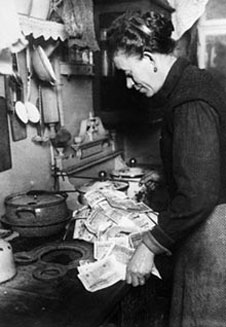Not afraid of inflation, but… (Rayonier)
With $787 billion in stimulus, $700 billion in TARP money, deficits projected to hit $1.8 trillion, the Federal Reserve cutting rates to effectively nothing, and Neil Barofsky, the government’s inspector general of TARP estimating a $23.7 trillion total risk exposure to the financial crisis, it is only natural to worry about inflation. Of course, that $23.7 trillion figure would require absolutely everything going wrong, but recent events have surely convinced us that betting on the modal result and ignoring the other possible outcomes is reckless, a fact that seems destined to be rediscovered every few years.
 Inflation, of course, is simply an increase in the money supply that outpaces an increase in the size of the economy (actually, that’s stagflation, but stagflation is really the pernicious aspect of inflation). The purpose of money is to facilitate transactions, and as the number of transactions increases the size of the money supply should increase accordingly. Now, of course, the economy has shrunk even as all this stimulus is being thrown at the market, and we are still worrying about deflation. This implies one of two things, either that inflation is going to come later, or that the inflation has been avoided.
Inflation, of course, is simply an increase in the money supply that outpaces an increase in the size of the economy (actually, that’s stagflation, but stagflation is really the pernicious aspect of inflation). The purpose of money is to facilitate transactions, and as the number of transactions increases the size of the money supply should increase accordingly. Now, of course, the economy has shrunk even as all this stimulus is being thrown at the market, and we are still worrying about deflation. This implies one of two things, either that inflation is going to come later, or that the inflation has been avoided.
I fall in the inflation avoidance camp. In a modern economy, credit serves almost as well as cash, and we are now witnessing a massive evaporation of credit. The appetite for securitization products that created a pool of liquidity that so many lenders were counting on turned out to be a mile wide and an inch deep. Now that every lender in the country is reining in its operations, and many people are unwilling to borrow or incapable of borrowing against their houses, trillions of dollars of credit that used to be bouncing around the financial system no longer are. Next to this unprecedented deleveraging of America, Congress has finally managed to make a couple trillion dollars look like a small number.
Of course, it never hurts to have a backup plan in the form of inflation-protected investments. Our choices include gold, TIPS, and land. For our fructivorous purposes, however, we want an investment that produces a decent return with or without inflation. Gold or other precious metals has no baseline return, or even a negative one when counting storage, insurance, etc. TIPS pay a low rate but increase their principal value alongside inflation, which is better than gold, but I still think there are more potential opportunities in the land category.
In terms of land, obviously single family homes are far too speculative as events have indicated. In fact, using Seth Klarman’s definition that a speculation, as opposed to an investment, produces no current or potential cash flow to its owner, single family homes are not an investment at all. Rental properties are closer, but I think the ideal land for an inflation hedge is land that produces something: farmland, mines, oil fields, or timber. Any of these has advantages and disadvantages, but I’m going with timber, and with Rayonier in particular.
 Rayonier owns 2.6 million acres of timberland, and also produces lumber and wood products, and wood fibers for hygiene products and also specialty fibers for industrial use running the gamut from packaging to LCD displays. Naturally the decline in demand for construction materials has hurt them, but even at this low ebb of their business, they have managed to squeeze out at least $25 million in earnings per quarter lately. Their free cash flows are approximately equal to their dividends, currently yielding 5%. This puts them at risk of a dividend cut, but for inflation hedging purposes this is not really relevant, as it is better to keep the money in the firm to buy more timberland with in that event.
Rayonier owns 2.6 million acres of timberland, and also produces lumber and wood products, and wood fibers for hygiene products and also specialty fibers for industrial use running the gamut from packaging to LCD displays. Naturally the decline in demand for construction materials has hurt them, but even at this low ebb of their business, they have managed to squeeze out at least $25 million in earnings per quarter lately. Their free cash flows are approximately equal to their dividends, currently yielding 5%. This puts them at risk of a dividend cut, but for inflation hedging purposes this is not really relevant, as it is better to keep the money in the firm to buy more timberland with in that event.
The advantage of timberland is that when, as now, demand is down, producers can simply decline to harvest. Unlike farmland, and especially mines and oilfields, not harvesting for a time allows the product of the land, trees in this case, to grow and produce a greater yield when conditions return to normalcy. And given their vertically integrated fiber business, they are not wholly dependent on the construction market.
 Rayonier also is getting a nice little bonus from the tax system this year from black liquor, a byproduct of the fiber refining process that contains the nonfibrous parts of the wood and the leftover chemicals used in the process. The refining of wood into wood pulp for their fiber business produces some nice long usable fibers, and a great deal of black slime. A highly toxic black slime. When dried, a highly flammable black slime. When dried and mixed with a bit of diesel fuel, a highly lucrative black slime, since the government pays a subsidy of 50 cents a gallon for its use under an alternative energy program. The program expires at the end of this year, and there is a movement in Congress to cut off the eligibility of pulp mills immediately, on the grounds that black liquor is not really an alternative fuel. (It has been used since the 30s and nearly every pulp mill uses it, meaning that it is not an “alternative” to anything.) To date this year, Rayonier has benefited $86 million from this subsidy, and there are two more quarters. Since the program will expire if not extended (which extension is not outside the realm of possibility), we cannot count on this $43 million a quarter as part of the firm’s operating income, but it is a nice little enhancement that will cushion the blow of the business slowdown for the moment.
Rayonier also is getting a nice little bonus from the tax system this year from black liquor, a byproduct of the fiber refining process that contains the nonfibrous parts of the wood and the leftover chemicals used in the process. The refining of wood into wood pulp for their fiber business produces some nice long usable fibers, and a great deal of black slime. A highly toxic black slime. When dried, a highly flammable black slime. When dried and mixed with a bit of diesel fuel, a highly lucrative black slime, since the government pays a subsidy of 50 cents a gallon for its use under an alternative energy program. The program expires at the end of this year, and there is a movement in Congress to cut off the eligibility of pulp mills immediately, on the grounds that black liquor is not really an alternative fuel. (It has been used since the 30s and nearly every pulp mill uses it, meaning that it is not an “alternative” to anything.) To date this year, Rayonier has benefited $86 million from this subsidy, and there are two more quarters. Since the program will expire if not extended (which extension is not outside the realm of possibility), we cannot count on this $43 million a quarter as part of the firm’s operating income, but it is a nice little enhancement that will cushion the blow of the business slowdown for the moment.
However, without counting the black liquor subsidy Rayonier’s PE ratio is hovering around 20, which is generally too high to qualify as a low-hanging fruit considering the lack of growth (not that a fructivore lays too much emphasis in growth anyway given the difficulty of predicting the future). But as an inflation hedge, timber companies like Rayonier are definitely good places to look into.
I like the idea of investing in companies with large inflation resistant holdings like Rayonier’s forests.
It makes me wonder how well some of the large holders of copper will do in the over the next 20 years with copper prices skyrocketing. While their mining yields will continue to decline as they extract resources, the value of their real estate with copper potential (mines) should continue to grow.